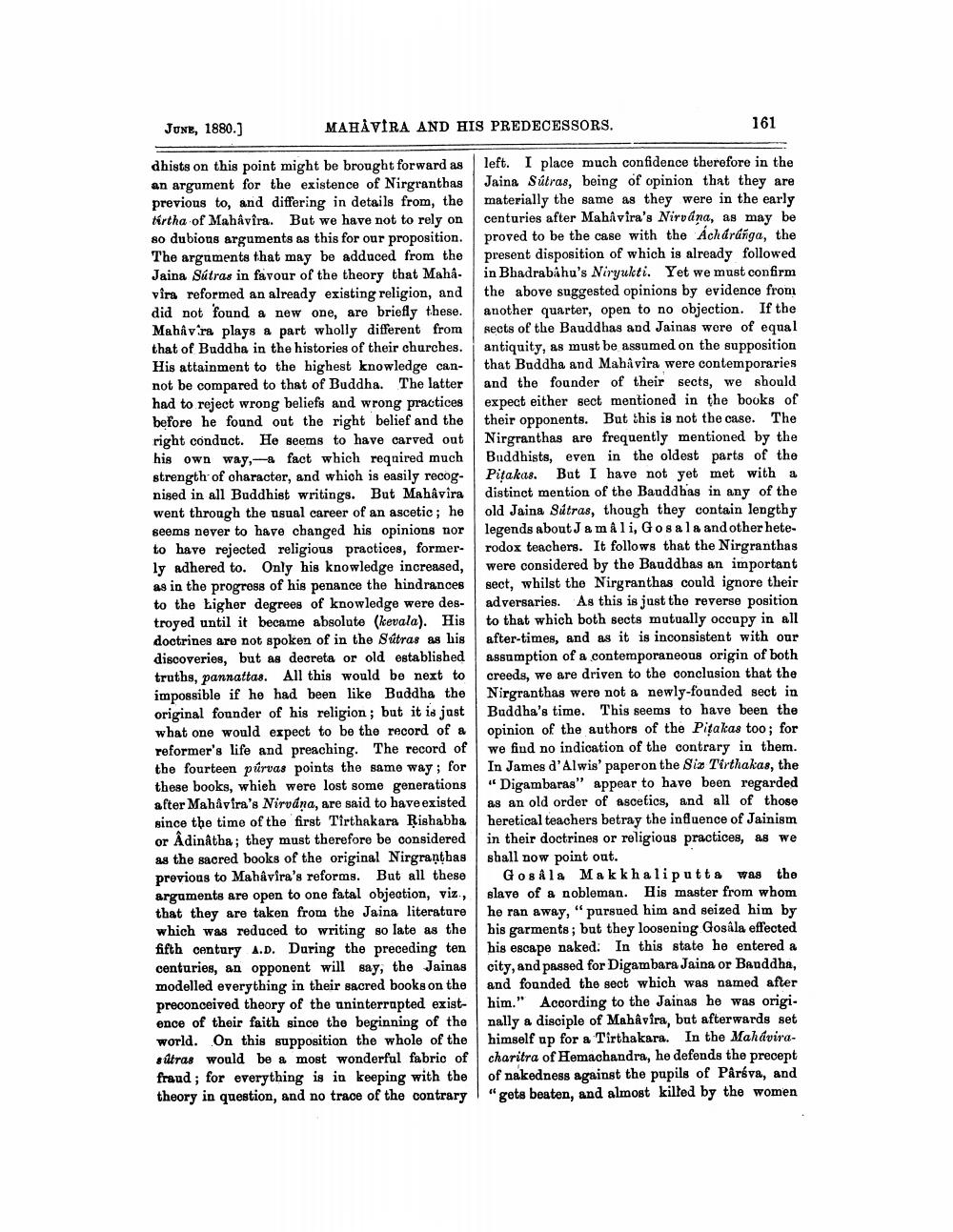________________
MAHAVIRA AND HIS PREDECESSORS.
JUNE, 1880.]
dhists on this point might be brought forward as an argument for the existence of Nirgranthas previous to, and differing in details from, the tirtha of Mahavira. But we have not to rely on so dubious arguments as this for our proposition. The arguments that may be adduced from the Jaina Sútras in favour of the theory that Mahâvira reformed an already existing religion, and did not found a new one, are briefly these. Mahavira plays a part wholly different from that of Buddha in the histories of their churches. His attainment to the highest knowledge cannot be compared to that of Buddha. The latter had to reject wrong beliefs and wrong practices before he found out the right belief and the right conduct. He seems to have carved out his own way, a fact which required much strength of character, and which is easily recognised in all Buddhist writings. But Mahavira went through the usual career of an ascetic; he seems never to have changed his opinions nor to have rejected religious practices, formerly adhered to. Only his knowledge increased, as in the progress of his penance the hindrances to the higher degrees of knowledge were destroyed until it became absolute (kevala). His doctrines are not spoken of in the Sutras as his discoveries, but as decreta or old established truths, pannattas. All this would be next to impossible if he had been like Buddha the original founder of his religion; but it is just what one would expect to be the record of a reformer's life and preaching. The record of the fourteen purvas points the same way; for these books, which were lost some generations after Mahavira's Nirvana, are said to have existed since the time of the first Tirthakara Rishabha or Adinatha; they must therefore be considered as the sacred books of the original Nirgranthas previous to Mahavira's reforms. But all these arguments are open to one fatal objection, viz., that they are taken from the Jaina literature which was reduced to writing so late as the fifth century A.D. During the preceding ten centuries, an opponent will say, the Jainas modelled everything in their sacred books on the preconceived theory of the uninterrupted existence of their faith since the beginning of the world. On this supposition the whole of the sutras would be a most wonderful fabric of fraud; for everything is in keeping with the theory in question, and no trace of the contrary
161
left. I place much confidence therefore in the Jaina Sutras, being of opinion that they are materially the same as they were in the early centuries after Mahavira's Nirvana, as may be proved to be the case with the Ácháránga, the present disposition of which is already followed in Bhadrabahu's Niryukti. Yet we must confirm the above suggested opinions by evidence from another quarter, open to no objection. If the sects of the Bauddhas and Jainas were of equal antiquity, as must be assumed on the supposition that Buddha and Mahavira were contemporaries and the founder of their sects, we should expect either sect mentioned in the books of their opponents. But this is not the case. The Nirgranthas are frequently mentioned by the Buddhists, even in the oldest parts of the Pitakas. But I have not yet met with a distinct mention of the Bauddhas in any of the old Jaina Sútras, though they contain lengthy legends about Jamali, Gosala and other heterodox teachers. It follows that the Nirgranthas were considered by the Bauddhas an important sect, whilst the Nirgranthas could ignore their adversaries. As this is just the reverse position to that which both sects mutually occupy in all after-times, and as it is inconsistent with our assumption of a contemporaneous origin of both creeds, we are driven to the conclusion that the Nirgranthas were not a newly-founded sect in Buddha's time. This seems to have been the opinion of the authors of the Pitakas too; for we find no indication of the contrary in them. In James d'Alwis' paper on the Six Tirthakas, the "Digambaras" appear to have been regarded as an old order of ascetics, and all of those heretical teachers betray the influence of Jainism in their doctrines or religious practices, as we shall now point out.
Gosala Makkhaliputta was the slave of a nobleman. His master from whom he ran away, "pursued him and seized him by his garments; but they loosening Gosâla effected his escape naked: In this state he entered a city, and passed for Digambara Jaina or Bauddha, and founded the sect which was named after him." According to the Jainas he was originally a disciple of Mahavira, but afterwards set himself up for a Tirthakara. In the Mahaviracharitra of Hemachandra, he defends the precept of nakedness against the pupils of Pâréva, and "gets beaten, and almost killed by the women.




